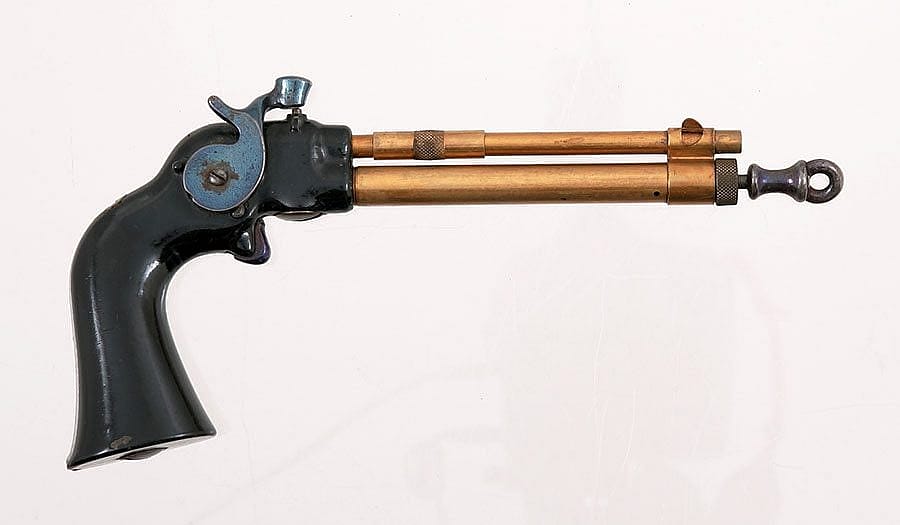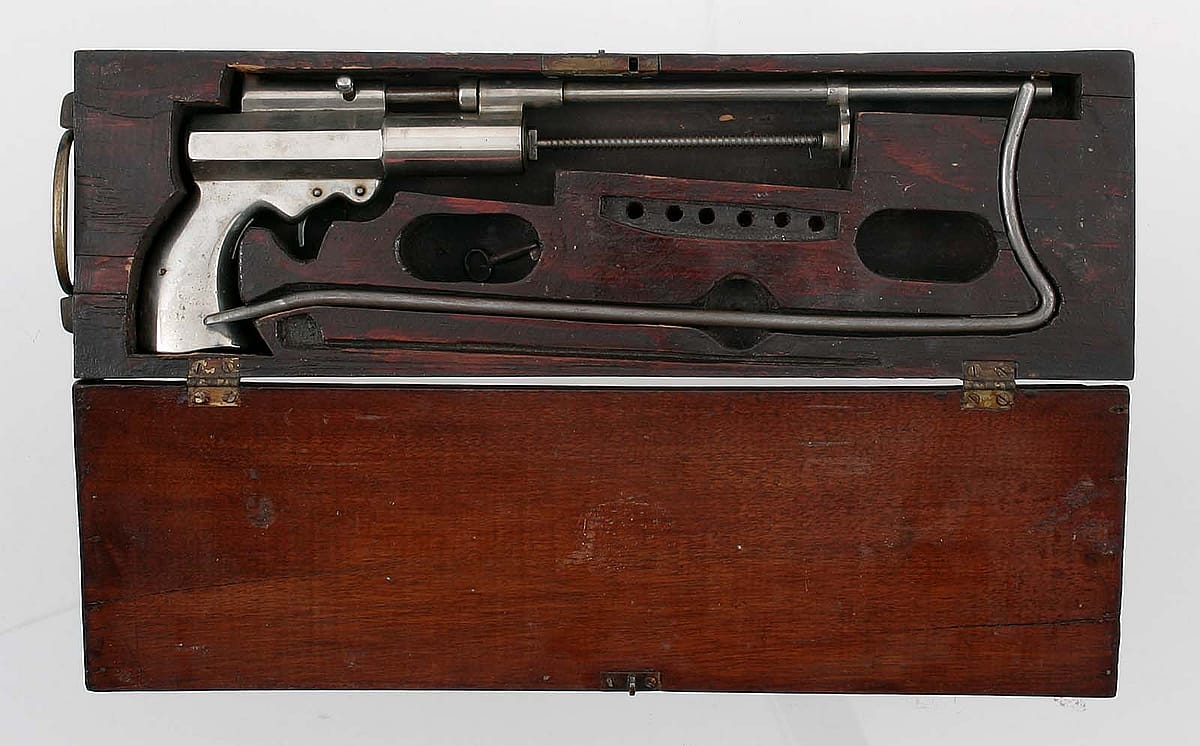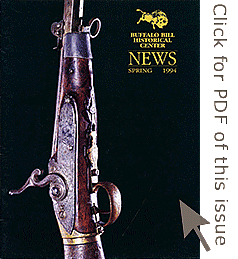
The American Air Gun – Points West Online
Originally published in Points West magazine
Spring 1994
The American Air Gun: From Western Wonder to Gallery Gadget to Tot’s Toy
By Howard Michael Madaus
Former Curator of the Cody Firearms Museum, Robert W. Woodruff Firearms Chair
“Every article about as appeared to excite astonishment in their [the Shoshone’s] minds; the appearance of the men, their arms, their clothing, the canoes, our manner of working them, the black man fork, and the sagacity of our dog, were equally objects of admiration. I also shot my air gun which was so perfectly incomprehensible that they immediately denominated it the great medicine. The idea which the Indians mean to convey by the appellation is something that emanates from or acts immediately by the influence or power of the Great Spirit, or that, in which, the power of god is manifest by its incomprehensible power of action.” —from the Journal of Meriwether Lewis, 17 August 1805

Air guns, which rely on compressed air rather than explosive gases to send projectiles down their barrels, undoubtedly existed as curiosities in the Americas prior to the nineteenth century. They had, after all, been widely used in Europe since the sixteenth century, so the technology was readily available, especially in American communities having strong Germanic origins. Not until the publication of the journals of Lewis and Clark, however, was the use of air guns in North America much mentioned. The Lewis and Clark journals documented the use of Captain Lewis’s air gun on no fewer than eighteen occasions.
Meriwether Lewis’s air gun was most likely purchased in Philadelphia, where most of the equipment for the expedition was acquired. At the time of the expedition, the only Philadelphia gunsmith making air guns was Isaiah Lukens. Two of the four known surviving Lukens air guns were included in the 1994 The American Air Gun exhibition.
Isaiah Lukens and Jacob Kuntz, who moved from Whitehall, Pennsylvania to Philadelphia in 1807, were the two American air gun makers of what would be called the “butt reservoir” type air gun. In this type, the detachable iron buttstock of the gun served as the chamber for the compressed air. A separate pump, resembling a pump for inflating bicycle tires, screwed into the detached reservoir for charging the device with compressed air. The “butt reservoir” type air gun was but one of various air guns in the exhibition.
Shortly before the American Civil War, air and spring guns began to be used not only for sport hunting, but also in target galleries. They continued to be popular in urban centers after the end of the war. The large trade and progress expositions and their accompanying diversions (including shooting galleries) seem to have been the prime factor behind this transition.
Five mechanical types of nineteenth-century gallery air guns have been categorized, each emanating from a different part of the United States—two from New York City, one from New England, one from upstate New York, and one from the Ohio River Valley and St. Louis. These small bore gallery rifles were well suited for urban gallery target shooting-since the projectile was small and the capacity of the cylindrical air chambers was low, range and destructive power was limited.
Until the 1870s, all air guns were handmade by gunsmiths who understood the complexities of the thirty-some parts that typified a New York City air gun. That changed in 1871, when Henry M. Quackenbush introduced his patented and much simplified air pistol, which required half as many parts as its predecessors and cost from half to two-thirds the price of competing gallery guns and gallery firearms. Several companies produced Quackenbush’s design under agreement or license with him.
Meanwhile Quackenbush opened his own factory in Herkimer, New York. Sales were brisk; 2,322 air guns were sold in 1883 and 2,919 in 1884. As a result a new four-story factory was constructed in 1890. Between 1893 and 1923, Quackenbush sold 40,677 of his gallery air guns. Sales slumped considerably during the Great Depression, and he was soon outstripped by his competition.
Many a young person fondly remembers the day that he or she received his or her first gun. More often than not that gun was a Daisy air rifle. Indeed, sales of Daisy air guns in 1952 totaled more than one and a quarter million! Yet the Daisy product line had a humble beginning. The company’s organizer, Clarence Hamilton, had begun business in Plymouth, Michigan, manufacturing patented iron windmills. In 1888 a disgruntled salesman from the Markham Air Rifle Company, which made all-wood air guns in Plymouth, suggested to Hamilton the idea of producing an all-metal air gun.
Thus was born the product line of the Daisy Manufacturing Company, as it was called after 1895. Assisted by a progressive advertising campaign, creative management, and a monopolistic drive, the Daisy air rifle became the main agent of transforming the adult’s gallery air gun to the toy gun that lay beneath the decorated evergreen tree on Christmas morning.
The American Air Gun, [an exhibition that appeared at the Buffalo Bill Center of the West at the time this article was published in 1994], traced the history of air guns in the United States from their practical uses on the frontier in the early nineteenth century through their recreational functions in urban America in the middle of the twentieth century. The exhibition was based on the collection of 108 air guns donated to the Cody Firearms Museum by Thomas Hutchinson of Illinois in 1993.
Post 017
Written By
Nancy McClure
Nancy now does Grants & Foundations Relations for the Center of the West's Development Department, but was formerly the Content Producer for the Center's Public Relations Department, where her work included writing and updating website content, publicizing events, copy editing, working with images, and producing the e-newsletter Western Wire. Her current job is seeking and applying for funding from government grants and private foundations. In her spare time, Nancy enjoys photography, reading, flower gardening, and playing the flute.











